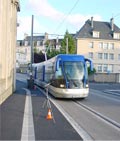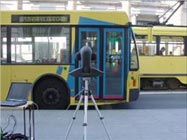SP2: Vehicle sources
Considerations
Subproject 2 is concerned with the perception of vehicle noise sources like cars, trucks, busses, motorbikes, trams, surface metros and trains. This project will investigate the level of contribution for the various vehicle noise sources using good quality road, rail and wheel surfaces. These noise sources will be further evaluated from a quantitative point of view to obtain an insight in why some noise is perceived as more aggressive. The project will consider a variety of mitigation options that are not only limited to technical solutions, but also include traffic control; measures and driver behaviour.
Workpackage 1: Identify/rank perception of noise sources under the conditions constant speed, acceleration/deceleration and standstill (loading/unloading)
- Qualitative identification of relative importance of wheel, rail, traction, exhaust, tyre, road, … for different transportation means based upon evaluation of existing data bases (considering good quality road surface and good quality wheel/rail surfaces).
- Evaluate evolution of noise source intensities in future taking into account future requirements of pass-by noise tests.


Workpackage 2: Subjective perception of noise sources
- Identification of modern vehicles which comply with pass-by noise test requirements.
- Evaluation of noise perception of these vehicles:
- Identify more "aggressive" sources;
- Define "penalty" or "premium" values for different noise sources according perception of noise.
Workpackage 3: Evaluate noise mitigation measures
- Retrofit measures (shielding of sources, vehicle skirts, …): analysis based on existing know-how.
- Traffic control measures Noise reduction action plans need to take into account a wide range of different options to reduce noise. In order to relate technical improvements investigated in the Qcityproject to other means of noise reduction, some effort will be put in calculation of such effects. This work package will look into the effects of traffic control measures in this respect. Method For global effects, the Sampers transportation modelling system (Transek, Sweden) will be used, which contains a multimodal travel demand model system. For more detailed analysis (hot spots and quiet areas), a micro simulation system like Aimsun (TSS, Spain) or Vissim (PTV, Germany) will be used. Different scenarios with respect to traffic control strategies will be analysed and compared.
- Driver behavioural measures to study impact of Intelligent Speed Adaptation systems, affecting individual acceleration and deceleration behaviour.
- Car ownership effects (car type restrictions) and effects of market take-up of low-noise vehicles. Scenarios:
- no policy change; general car restriction policy (congestion charges, traffic control, improved public transport supply);
- car type differentiated restriction policy;
- car type promotion policy.
- Interchange measures between different transportation means
The EU (Clean urban transport) is working to promote a more sustainable mobility by a number of measures. Many of these are directed towards changing to more sustainable modes:- promoting market take-up of lower-consumption vehicles and new propulsion technologies to reduce emissions;
- promoting the use of Improved collective and non-motorised modes in conjunction with mobility management schemes;
- demand management schemes such as parking controls and access restrictions;
- information systems for better traffic management and improving traffic flow;
- integrated intermodal freight and passenger transport systems such as city logistics and improved terminals;
- fair and efficient pricing regimes;
- supporting integrated land-use and urban transport planning to minimise the need to travel and facilitate collective transport;
- promoting efficient public transport modes to people with reduced mobility;
- supporting and promoting cycling;
- possible contribution of Teleworking.
- Rank all the above developed mitigation measures considering performance/cost, general applicability and general acceptance.